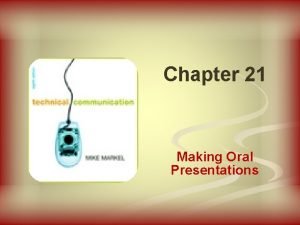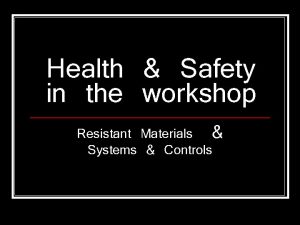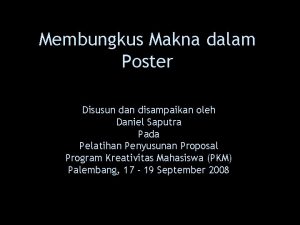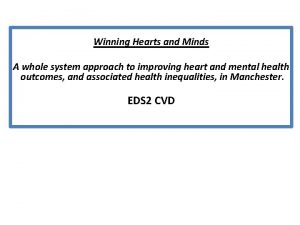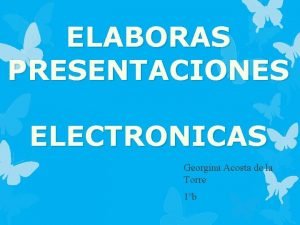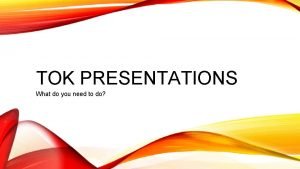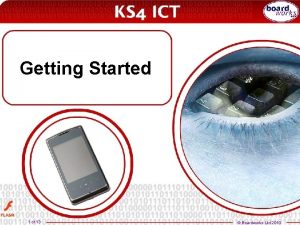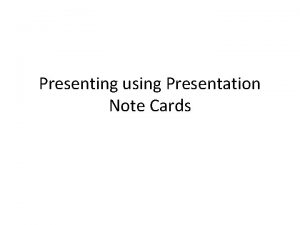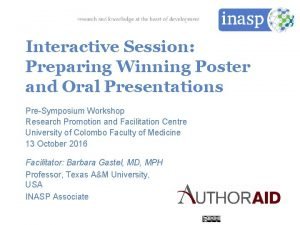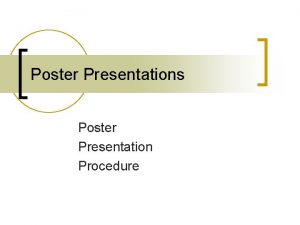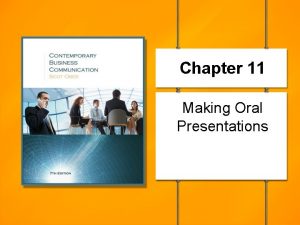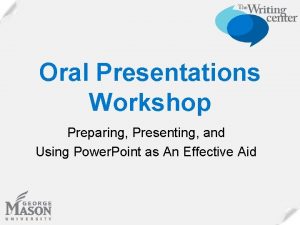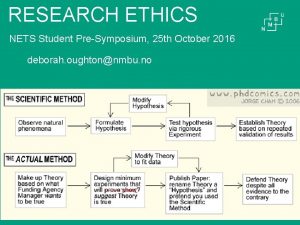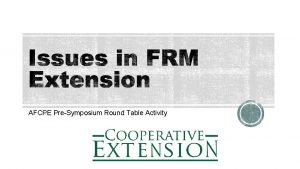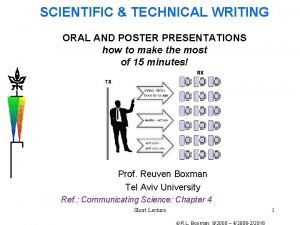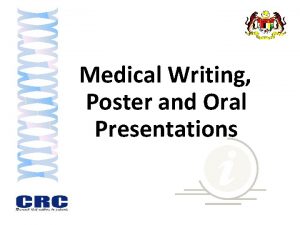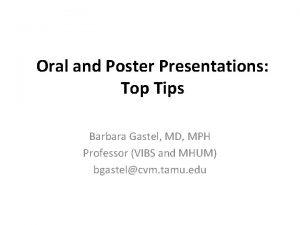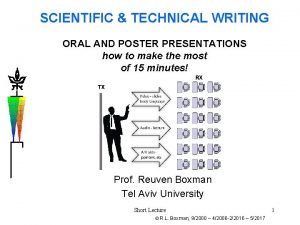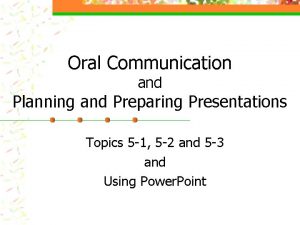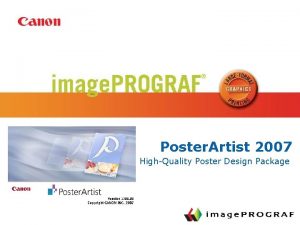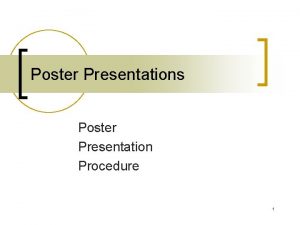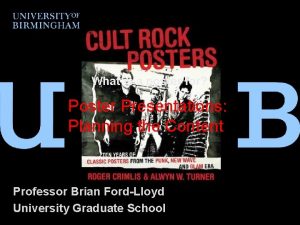Preparing Winning Poster and Oral Presentations PreSymposium Workshop
























- Slides: 24

Preparing Winning Poster and Oral Presentations Pre-Symposium Workshop Research Promotion and Facilitation Centre University of Colombo Faculty of Medicine 13 October 2016 Facilitator: Barbara Gastel, MD, MPH Professor, Texas A&M University, USA INASP Associate

Preparing and Giving Poster Presentations

Planning a Poster • • Choose a narrow enough topic. Plan to present only highlights. Obtain and carefully follow instructions. Select images that present key messages and attract viewers. • Plan to include little text (in general, about 500– 1000 words). • Plan to make the poster understandable on its own.

Organizing a Poster • Organize the poster logically (example: Introduction, Methods, Results, Conclusions). • If the poster has a “landscape” format, place the content in about 3 to 5 vertical columns. • Include plenty of white space. • In general, don’t include an abstract.

Preparing a Poster: The Title • Keep the title fairly short. • Perhaps try to make the title attention-grabbing. • Use large enough type – at least about 2. 5 cm, or 1 inch, high – in other words, at least 72 point type • Normally, don’t use all capital letters. – Example of a Poster Title – Example of a poster title – EXAMPLE OF A POSTER TITLE

Preparing a Poster: The Images • Use images (photographs, flow charts, graphs, etc) that both attract and inform. • Keep the images simple, so they can be quickly understood. • In general, use graphs, not tables. • Make the images large enough. • Remember to label each image. • Use color effectively.

Preparing a Poster: The Text • Keep the text brief. • Make the type large enough to read easily (in general, probably about 24 point). • Where feasible, use bulleted or numbered lists rather than paragraphs. • If paragraphs are used, keep them short. • Include your contact information. • Proofread the text carefully.

Presenting a Poster • Don’t be shy. • Think ahead about questions you might be asked. • Maybe prepare talks of various lengths. • Perhaps ask some questions. • Take advantage of the chance for feedback. • Take advantage of the chance to network.

Presenting a Poster (cont) • Have business cards available. • Consider having handouts. • Consider having people sign up for further information. • If you’ll write a paper about the work presented, keep in mind comments and questions from the poster session.

Some Newer Aspects • Electronic posters – Static (projection of traditional posters) – Dynamic • May have animations, videos, etc • May be interactive • Flash poster presentations (see http: //www. authoraid. info/en/news/details/ 406/)

Some Resources • “Designing Conference Posters” by Colin Purrington (posted at http: //colinpurrington. com/tips/posterdesign) • “Better Posters: A Resource for Improving Poster Presentations” (blog at http: //betterposters. blogspot. com/)

Preparing and Giving Oral Presentations

Preparing an Oral Presentation • Obtain and carefully follow instructions. • Include much less detail than in a paper to publish. • Stick to the main idea. • Give the presentation a beginning, a middle, and an end. • If feasible, structure the presentation largely as a story.

Preparing a Presentation (cont) • Remember: People must be able to understand what you say as you say it. Therefore, for example: – Pace the presentation carefully. – Repeat important points. • Minimize use of abbreviations/acronyms. • In general, prepare notes, not a full text.

Preparing Slides: Some Guidelines • • • At most one slide per minute, on average One theme or idea per slide Simple and uncrowded Thus, usually no published graphs/tables Bullet points (not paragraphs) for most text • Large enough lettering to read

Compare this slide and the previous one. In general, do not average more than one slide per minute. Limit each slide to one theme or idea. Keep slides simple and uncrowded. Thus, beware of using published graphs and tables. In general, use bullet points (not paragraphs) for text. Make sure all lettering is large enough to read.

Rehearsing the Presentation • Time the presentation carefully. • Try to make the presentation slightly shorter than the allotted time. • Perhaps rehearse for others. • Perhaps have others ask you questions.

Coping with Stage Fright • Note that a little nervousness can help you perform well. • Realize that people will attend to hear the content, not to judge your speaking style. • Prepare well, but don’t over-prepare. • Exercise a little. • Beware of too much food, water, or caffeine.

Coping with Stage Fright (cont) • Hide physical signs of anxiety. • Realize that a presentation need not be perfect to be excellent.

Giving the Presentation • • Arrive early. Make sure audiovisuals are working. Speak slowly enough. Speak clearly. Look at the audience. Show enthusiasm. Avoid distracting habits.

Answering Questions • Lay the groundwork for relevant questions (for example, by stating in your talk some items that people can ask about). • Perhaps have the moderator or a colleague to ask the first question. • Briefly repeat each question. • Keep answers brief.

Answering Questions (cont) • If you don’t know an answer, say so. Perhaps – offer to find out, – suggest how to find out, or – see if someone present has the answer. • If a question seems irrelevant, offer to answer it later, or move to a related item. • If a question is hostile, answer politely and briefly; perhaps offer to talk later.

Answering Questions (cont) • Make note of questions. Use them to help shape future presentations and publications about the work.

This work is licensed under a Creative Commons Attribution Share. Alike 4. 0 International licence. 06/03/2021 24
 Designing and delivering oral and online presentation
Designing and delivering oral and online presentation Types of oral presentations
Types of oral presentations Brazing hearth diagram
Brazing hearth diagram Poster making adobe
Poster making adobe World's worst presentation
World's worst presentation Awful powerpoint presentations
Awful powerpoint presentations Pesan yang disampaikan dalam poster biasanya melalui
Pesan yang disampaikan dalam poster biasanya melalui Winning hearts and minds manchester
Winning hearts and minds manchester Craft of scientific presentations
Craft of scientific presentations Introduction to mental health awareness presentation
Introduction to mental health awareness presentation What are multimedia presentations
What are multimedia presentations Slidetodoc.com
Slidetodoc.com Desventajas de corel presentations
Desventajas de corel presentations What is verbal support
What is verbal support Tok presentations
Tok presentations Anna ritchie allan
Anna ritchie allan Ria seminar presentations
Ria seminar presentations Boardworks flash
Boardworks flash Situation complication question answer
Situation complication question answer Internet presentations
Internet presentations The most dangerous game powerpoint
The most dangerous game powerpoint Note card for presentation
Note card for presentation The end pictures for presentations
The end pictures for presentations Useful phrases presentation
Useful phrases presentation Efficient elements license key
Efficient elements license key

